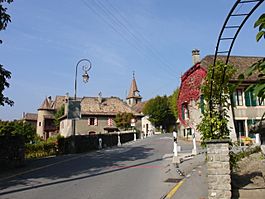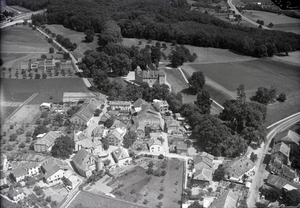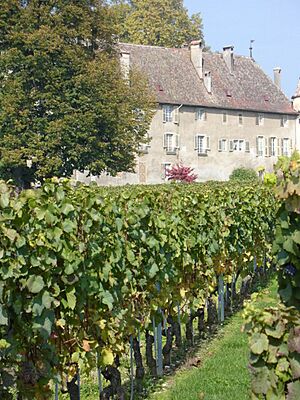Allaman facts for kids
Quick facts for kids
Allaman
|
||
|---|---|---|

Allaman village
|
||
|
||
| Country | Switzerland | |
| Canton | Vaud | |
| District | Morges | |
| Area | ||
| • Total | 2.6 km2 (1.0 sq mi) | |
| Elevation | 408 m (1,339 ft) | |
| Population
(Dec 2020 )
|
||
| • Total | 442 | |
| • Density | 170/km2 (440/sq mi) | |
| Postal code |
1165
|
|
| Surrounded by | Aubonne, Etoy, Buchillon, Perroy, Féchy | |
Allaman is a small town, also called a municipality, located in the Vaud area (or canton) of Switzerland. It's part of the Morges district. Allaman is well-known for its amazing medieval Allaman Castle, which was built way back in 1253 by the Count of Vaud.
Contents
Allaman's History
When Allaman Was First Known
The town of Allaman was first written about in history books in the year 1234. Back then, it was called Alamant.
Allaman Castle
A Famous Swiss Castle
Allaman Castle is a very old and large private property in Switzerland. It covers a huge area of about 330,000 square meters, which is like 85 football fields! The castle itself has about 6,000 square meters of living space. It's surrounded by private forests, beautiful gardens, and even its own vineyards.
Famous Visitors and Important Ideas
A long time ago, a kind person from Geneva named Jean-Jacques de Sellon owned the castle until 1839. He often let important political refugees stay there. Some of these famous guests included Joseph Bonaparte (Napoleon's brother), Joséphine de Beauharnais, and even the famous writer Voltaire. The musician Franz Liszt and writer George Sand also visited.
In 1830, Jean-Jacques de Sellon started something called the Society of Peace. This group was an early version of big international organizations like the League of Nations and the United Nations Organization (UNO), which work to keep peace in the world.
Modern Updates for an Old Castle
Around 2012, the castle finished a big five-year project. This project carefully restored the old parts of the castle from the 12th century. It also added modern comforts and safety features for today's living. A Swiss-German family now owns this historic property.
Allaman's Location
Where is Allaman?
Allaman is located right next to Lake Geneva. It sits on the right side of the Aubonne river.
Land Use in Allaman
About 58% of Allaman's land is used for farming. Forests cover about 17% of the area. The rest of the land, about 23%, has buildings and roads. A small part, about 1%, is unproductive land.
Allaman used to be part of the Rolle District. But in 2006, it became part of the new Morges district.
Allaman's Coat of Arms
What the Town Symbol Means
The official symbol, or coat of arms, for Allaman is described as Gules, three wavy bars Argent. This means it has a red background (Gules) with three wavy silver (Argent) lines.
People of Allaman
Who Lives in Allaman?
Allaman has a population of about 400 people. In 2008, about 25% of the people living in Allaman were from other countries.
Languages Spoken
Most people in Allaman speak French, which is about 86% of the population. The next most common language is German, spoken by about 4% of the people. About 3% of the people speak Portuguese.
Where People Were Born
In 2000, about 25% of the people living in Allaman were born there. About 33% were born in the same canton (Vaud). Around 13% were born in other parts of Switzerland, and about 26% were born outside of Switzerland.
Population Changes Over Time
The number of people living in Allaman has changed over many years. Here is a chart showing how the population has grown and shrunk:

Important Heritage Sites
Allaman Castle's Special Status
Allaman Castle is very important to Switzerland's history and culture. It is listed as a heritage site of national significance. This means it's a protected and valued place.
Allaman's Economy
How People Work in Allaman
In 2010, the unemployment rate in Allaman was about 4.2%. This means most people who wanted to work had jobs.
Many people in Allaman work in different areas:
- Primary sector: About 56 people work in farming.
- Secondary sector: About 51 people work in manufacturing (making things).
- Tertiary sector: About 366 people work in services, like sales, hotels, restaurants, and education.
In 2000, about 88 workers came into Allaman for their jobs, while 142 workers left Allaman to work in other towns. This means more people from Allaman work outside the town than those who come in. About 11% of workers use public transportation, and about 58% use a private car to get to work.
Religion in Allaman
Beliefs of the People
Based on a survey in 2000, about 19.6% of the people in Allaman were Roman Catholic. A larger group, about 50.3%, belonged to the Swiss Reformed Church. There were also smaller numbers of people who were Orthodox Christian (1.5%), other Christians (4%), or Islamic (4.3%). About 16.5% of the population did not belong to any church.
Education in Allaman
Schools and Learning
About 31.9% of the people in Allaman have finished upper secondary education, which is like high school. About 19.6% have gone on to higher education, like a university.
In the 2009/2010 school year, there were 43 students in Allaman's schools. In the Vaud area, children can go to two years of optional pre-school. Primary school lasts for four years, and there were 22 students in Allaman's primary schools. Lower secondary school lasts for six years, and 21 students were in those schools.
In 2000, 23 students came to Allaman to go to school from other towns. At the same time, 70 students from Allaman went to schools outside the municipality.
Transportation
Getting Around Allaman
Allaman has its own railway station, called Allaman. This station is on the main Lausanne–Geneva line. You can catch regular trains from Allaman to places like Annemasse, Lausanne, St-Maurice, and Palézieux.
Images for kids
See also
 In Spanish: Allaman para niños
In Spanish: Allaman para niños








